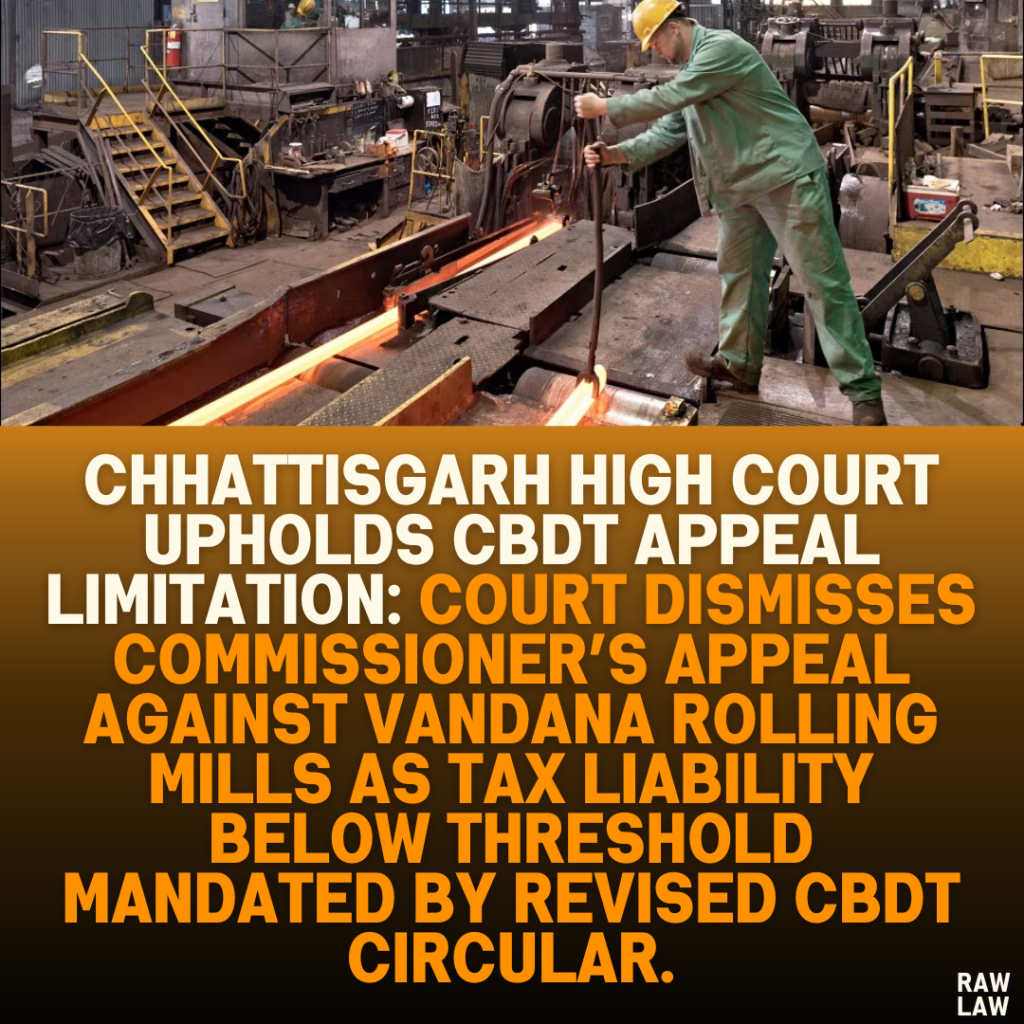Court’s Decision:
The High Court of Chhattisgarh dismissed the appeal filed by the Principal Commissioner of Income Tax (Raipur-1) against Vandana Rolling Mills Ltd., as the tax liability in the case was less than ₹2 crore. This was in accordance with a revised circular issued by the Central Board of Direct Taxes (CBDT) on 17.09.2024, which raised the monetary limits for filing appeals. The court, recognizing the objective of the circular, disposed of the appeal as withdrawn.
Facts:
- Parties Involved: The appeal was filed by the Principal Commissioner of Income Tax against a taxpayer (respondent) for the assessment year 2017–18.
- Tax Liability: The tax liability of the respondent in the case was determined to be less than ₹2 crore.
- CBDT Circular: During the pendency of the case, the Ministry of Finance issued a circular dated 17.09.2024, revising the monetary limits for filing appeals in income tax cases. The circular raised the threshold for filing appeals before:
- The Income Tax Appellate Tribunal (ITAT) to ₹60 lakh,
- High Courts to ₹2 crore, and
- The Supreme Court to ₹5 crore.
- The Principal Commissioner, acknowledging the revised threshold, submitted a request to withdraw the appeal.
Issues:
The primary issue before the court was:
- Whether the appeal should be entertained when the tax liability of the respondent was below the revised monetary limit of ₹2 crore set by the CBDT circular.
Petitioner’s Arguments:
- Acknowledgment of Tax Liability: The counsel for the appellant (Principal Commissioner of Income Tax) admitted that the tax liability in the present case was below ₹2 crore.
- Reference to CBDT Circular: The petitioner relied on the CBDT circular dated 17.09.2024, emphasizing that the revised monetary limits should be applied to pending cases, and requested that the appeal be disposed of accordingly.
Respondent’s Arguments:
The respondent did not appear or present arguments during the proceedings.
Analysis of the Law:
- Revised Monetary Limits:
The court analyzed the implications of CBDT Circular No. 5/2024 (dated 15.03.2024), as amended on 17.09.2024, which aimed to reduce unnecessary litigation by revising the monetary limits for appeals. This was applicable to appeals pending before the Supreme Court, High Courts, and Tribunals. - Purpose of the Circular:
- The circular emphasized that appeals should only be filed based on the merits of the case, irrespective of the monetary limits, in exceptional cases (e.g., matters of law or public interest).
- For routine cases, adherence to the monetary thresholds was required to achieve the broader objective of reducing litigation and providing certainty in tax matters.
- Binding Nature of CBDT Circulars:
Section 268A of the Income Tax Act, 1961, grants the CBDT authority to issue binding instructions to tax authorities. The court noted that the circular was legally binding and had to be followed.
Precedent Analysis:
While no specific precedents were cited in the judgment, the court followed established principles that CBDT circulars are binding on tax authorities. Courts have consistently emphasized that such circulars should be applied uniformly to pending and prospective cases.
Court’s Reasoning:
- Acknowledgment of Facts:
The court took note of the appellant’s admission that the tax liability in this case was below ₹2 crore. - Purpose of the Circular:
The court highlighted that the circular was aimed at reducing litigation, ensuring that appeals are only filed for substantial matters. It observed that pursuing the present appeal would contradict the purpose of the revised monetary limits. - Applicability to Pending Cases:
Paragraph 5 of the circular clarified that the revised limits apply to both pending and future appeals, ensuring uniformity and adherence to the new thresholds.
Conclusion:
The court dismissed the appeal as withdrawn, holding that the tax liability in the case fell below the revised monetary limit of ₹2 crore. The decision aligned with the CBDT’s objective of minimizing unnecessary litigation and reducing the burden on courts.
Implications:
- Clarity for Tax Authorities:
The judgment reinforces the binding nature of CBDT circulars and underscores the importance of adhering to revised thresholds. Tax authorities must evaluate appeals against the monetary limits to ensure compliance. - Reduction in Litigation:
By applying the revised monetary limits, the judgment contributes to the CBDT’s goal of reducing unnecessary litigation. This, in turn, helps streamline judicial processes and improves the efficiency of the tax adjudication system. - Certainty for Taxpayers:
The decision provides taxpayers with greater certainty regarding assessments and appeals, ensuring that disputes are resolved promptly and in accordance with established thresholds. - Policy Impact:
The judgment reflects the judicial endorsement of government policy aimed at reducing the burden on courts and focusing on cases with significant tax implications.
